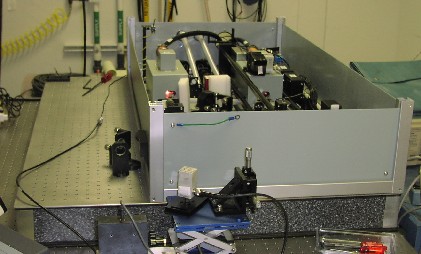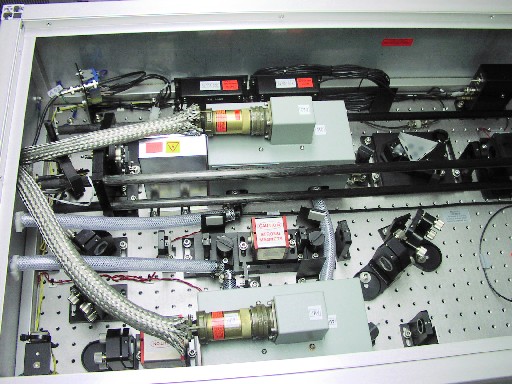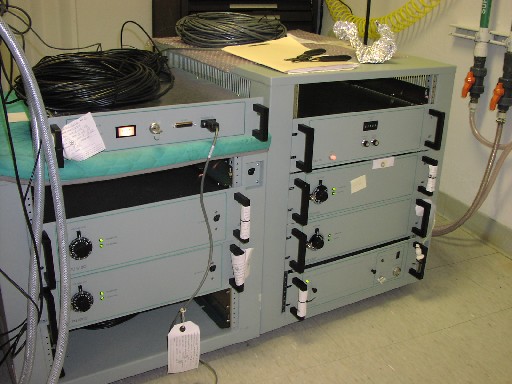Table of Contents
1. Apollo Laser
2. Laser Bench
3. Plan View
4. Laser Guts
5. Output End
6. Electronics Racks
7. Photo Diode
The laser used for APOLLO is a commercial, product-line laser called the Continuum Leopard. Its basic properties are:
- 532 nm wavelength (green)
- <100 ps pulse width
- 115 mJ per pulse
- 20 Hz repetition rate (yielding 2.3 W average power)
- 9 mm output beam size, M2=2.5
- 2×4×1.2 cubic foot volume (laser bench itself)
- 2.5% RMS pulse energy stability
The laser beam is expanded to fill the full aperture of the 3.5 meter Apache Point telescope. The beam quality is such that the atmospheric turbulence ("seeing") is the limiting factor in overall beam divergence enroute to the moon. Typical seeing at Apache Point is 1.0 arcseconds, translating to a 1.8 km diameter footprint at the distance of the moon.
The laser bench is oversized (3×4 ft2), allowing our receiver optics to occupy a spot on the same rigid structure. This bench is mounted onto the back port of the telescope (a bent Cassegrain focus), and enclosed in a temperature-controlled box to keep the laser at its desired operating temperature.

The laser is mounted on a 4-inch thick optical bench, occupying a 2ft × 4ft area, leaving a strip for mounting the steering optics and receiver. The black optical mount on the available bench space marks the position of the output. The laser is enclosed in a metal box, whose top is off in this picture.

This view shows the layout of all the laser optical components. Along the bottom is the laser cavity, defined by the long black carbon rods. The laser rod and flashlamps are contained within the large gray box near the right end of the cavity. To the right of this is the shielded Marx bank and Pockels cell responsible for dumping the cavity. To the left of the laser rod is the large delay prism for cavity-length adjustment, the saturable absorber for truncating the pulse, and the acousto-optic modulator that creates the pulse train. Along the very bottom wall is the photodiode used to detect build-up of optical energy, plus some power supplies (below the flashlamp housing). At upper right is the amplifier. In this case, the gray box cover has been removed to reveal the black cylindrical flashlamp/rod housing. At upper left is the gimballed crystal that produces second-harmonic light at 532 nm, followed by output optics.

The laser consits of a cavity (at top) and an amplifier (at bottom). Each has a Nd:YAG rod and flashlamp assembly, seen as the gray boxes fed by large power cables. To the left of the cavity flashlamp box is the shielded Marx bank, which is responsible for dumping the pulse out of the cavity when it has built up enough energy. Water hoses come in from the left and circulate coolant through the flashlamp housings to maintain a constant temperature profile in the rods.

The less cramped output end of the laser contains, from upper right to upper left:
- The frequency doubler crystal, which converts two 1.064 µm photons into a single 532 nm photon (green light). The efficiency of the conversion is sensitive to crystal orientation, so the crystal mounting block is situated in a motorized one-axis gimbal mount.
- A dichroic passes the residual infrared light to the left (about 1.5 W of un-converted IR power), turning (almost) all the green light 90° and out of the hole in the side of the laser box.
- The green light that leaks through the output coupler encounters a second dichroic, turning the remaining green light (well, 99.9% of it) toward the bottom of the picture.
- The IR light also passes through the second dichroic, and is terminated in the beam dump (white bird-house-looking thing).

The laser bench itself sits on the telescope, but the electronics racks need not. Here we see the two racks, one of which needs to be close to the laser bench, and the other not so close. In order to limit heat buildup in the dome, the rack on the left can be far away from the laser, in the intermediate level of the dome.
Control/Power Rack
The rack on the left contains the control unit (here seen on top of the rack), and two power units, one for each flashlamp head. The control unit sets the state of the laser, accepts remote configuration commands from the control computer, and responds to requests by the ACM to fire the laser. The Power units charge the capacitor banks, located in the other rack.
Capacitor/RF/Coolant Rack
The rack on the right contains (from top to bottom): The RF generator that is tuned to the cavity length and modulates the mode-locker; two capacitor banks that send the current surge to the flashlamps 20 times a second; and the water cooling control unit that regulates the flow and temperature of the laser head coolant. This rack needs to be near the laser bench, and will likely end up mounted on the telescope structure.










